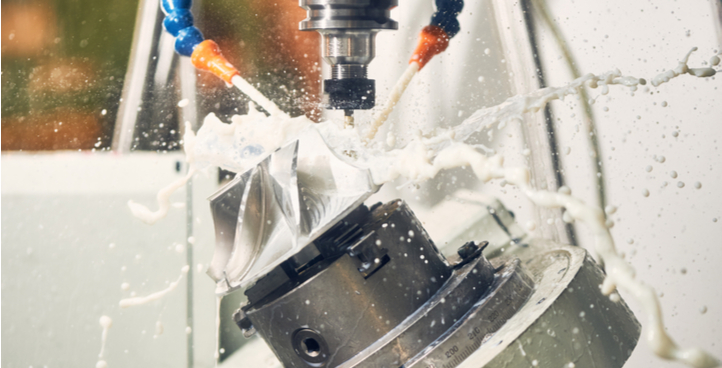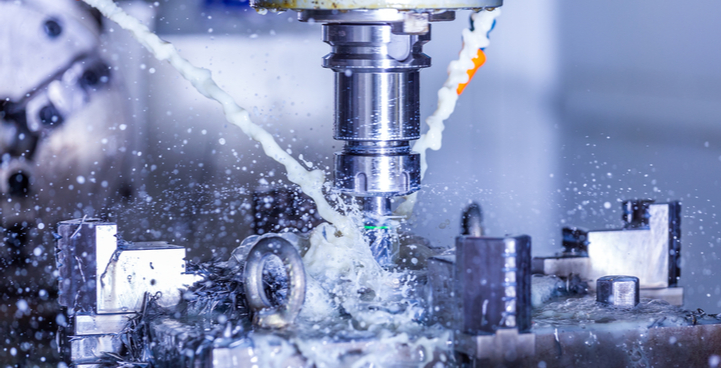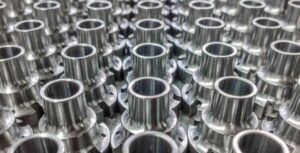Both vertical and horizontal machining have their advantages and disadvantages, but both still remain integral parts of manufacturing plants across the country. Learn more about the pros and cons of each below to see which might be best for your application.
Contact the team at Roberson Machine Company at 573-646-3996 if you have any questions about vertical, horizontal, or CNC milling of all types!
Vertical Milling: Pros and Cons
Vertical mills have a vertically-aligned spindle and cutting head that moves up and down the z-axis, pressing against the workpiece in order to shave away material. Meanwhile, the rest of the machine continuously positions the object for cutting by moving along the x-axis and y-axis, and there is always a direct line of visibility while the machine cuts. Vertical mills come in two varieties including bed mills and turret mills, each with their own pros and cons that work best for the type of application.
Pros:
- Cost-effective – There is a lower overall upfront cost of a vertical mill, plus the projects completed using it often cost less ultimately, which means production savings can be passed onto customers.
- Easy-to-use – Vertical mills are relatively easy to operate and require no additional fixtures. They give operators better visibility while working, which means that there is a better chance of spotting and correcting potential problems easily as the milling commences.
- Popular – In general, vertical machining centers make up the majority of milling machinery in the metalworking industry. This is ideal both in terms of skilled machinists available and finding replacement parts at a moment’s notice.
- Ideal for small shops – There are many reasons—including the above—why vertical mills are ideal for small shops or a manufacturing plant just starting out: ease-of-use, no significant upfront cost, less complicated jobs, low quantities, quick milling jobs, takes up less floor space, and more.
Cons:
- Not ideal for high-weight projects – As they can be harder to raise and lower on the vertical platform, it is not ideal for heavy objects.
- Lacking in production output – They cannot meet the demand for time and cost efficiency in large quantity, complex machining jobs. In short, they don’t offer as quick of an output rate as horizontal applications.
- Lower-horsepower motors – This may make it harder to handle some pieces, especially if they are complex.
Horizontal Milling: Pros and Cons
Horizontal mills have a horizontally-aligned spindle and cutting head instead of being fixed on a table. These horizontal cutters are thicker and shorter in order to perform heavier, deeper, and speedier cuts. They are mounted on the arm above the table, called an arbor, which means horizontal mills can use multiple cutters at once. The material is then fed from the three different axes.
Pros:
- Ideal for large, complex projects – If your object is heavy or requires more grooves, the horizontal mill has the versatility to meet these expectations. Its mechanical design allows it to do the work of three machining tools in one. This is ideal for time efficiency and productivity.
- Faster – If you require a fast turnaround time, a horizontal milling machine can cut at a higher speed and can also make cuts simultaneously. Additionally, beds can be rotated to enable milling at multiple angles rather than strictly on a horizontal plane. All of this allows for more speed, at no sacrifice to precision.
- Better chip removal – Because of its design, gravity allows the chips to fall and be removed easier. This translates to better surface finish, less fabrication needed later, and longer tool life.
Cons:
- Larger and more expensive – Because they are larger machines, they take up more space and have a higher upfront cost. However, you may have a need for a horizontal mill because of the advanced level of output and precise nature of the work you wish to complete, meaning it might pay for itself.
- Less common – Being less commonly available because of their price and maintenance, you may have trouble finding skilled operators for this type of machine. Also, if it suffers a breakdown, you may also have trouble finding replacement parts or other related services.
CNC Milling in Missouri | Roberson Machine Company
Weighing all of the pros and cons of both types of CNC milling processes may not be enough—you may have to look at all other considerations, including the design of the workpiece, your operating budget, and the timeline you are working with. Once you take into account all of these elements, you can make an informed decision on whether to choose horizontal or vertical milling.
Need help? Contact our team at 573-646-3996 or request a quote today for more information on our CNC milling services in Missouri.





